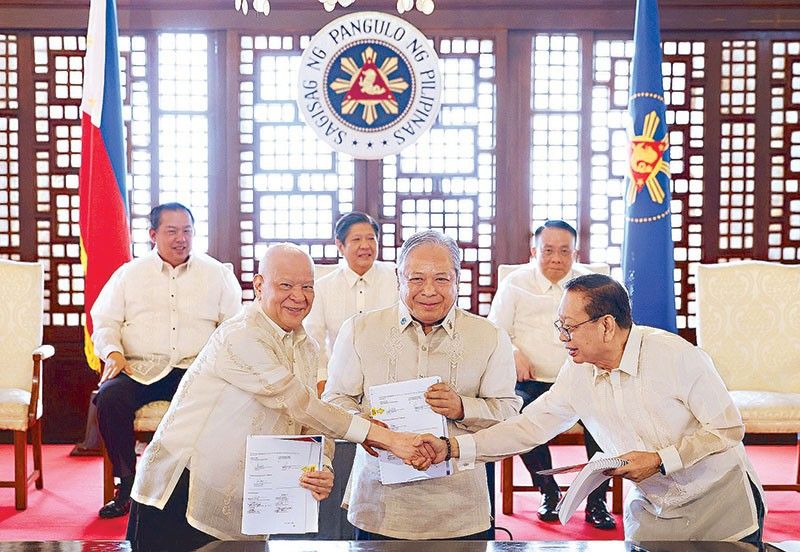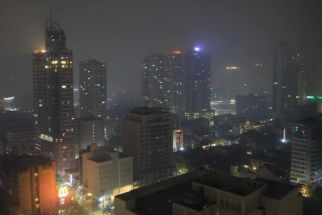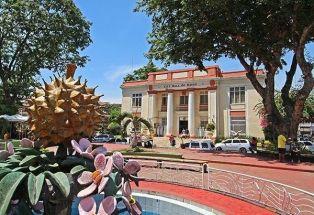New NAIA terminal eyed at Nayon site

Government, SMC-led group sign P170.6 billion deal for NAIA rehab
MANILA, Philippines — A new passenger terminal will rise at the Ninoy Aquino International Airport (NAIA) in three years, as part of the project of the new concessionaire led by San Miguel Corp. (SMC) to expand the country’s premier gateway to accommodate the growing demand for air travel.
SMC president and CEO Ramon Ang said the project would enable Filipinos to feel the benefits of privatizing NAIA as early as possible.
The New NAIA Infrastructure Corp., headed by SMC, will put up the new building near Terminals 1 and 2.
Ang said the new terminal would be built on the site of the abandoned Philippine Village Hotel within the Nayong Pilipino complex. The terminal would have at least 50 concourses which, after completion, would significantly push up the capacity of the airport in handling flights and passengers.
Ang said the concessionaire has to secure approval of the Department of Transportation and Manila International Airport Authority (MIAA) before it can proceed with the construction.
The concessionaire will also put up a multipurpose building to serve as the relocation site for airport regulators housed inside the terminals.
By moving them to another location, Ang hopes to clear up to 30 percent of space at Terminals 1, 2 and 3 that can be used to accommodate passengers.
The building would also have parking spaces for as many as 9,000 vehicles.
Ang said concessionaire would resolve the vehicle congestion at NAIA by as early as next year.
The operator will develop a direct access road from NAIA Expressway (NAIA-X) to Terminal 3 to improve the traffic flow within and around the airport.
The goal is to enable motorists to go in and out of NAIA within a 10-minute timeframe. SMC holds the concession for the Skyway System and NAIA-X, both of which are linked to NAIA.
Ang also bared plans to employ a digital system similar to the one being used in India, where travelers can scan their faces at home to speed up their pre-departure transactions at the airport.
Although tasked to change NAIA for the better, Ang said the concessionaire would preserve some elements at the airport. He also stressed he has no intention of renaming NAIA back to Manila International Airport, as proposed by some quarters, saying the focus of the privatization is on rehabilitation, not politics.
Financially, Ang said the concessionaire is backed by at least five banks, mainly BDO Unibank Inc. – the largest in the Philippines – in its P122.3-billion initiative to modernize NAIA. He shot down worries that the group may suffer a financial meltdown in the future.
The New NAIA Infrastructure Corp., formerly SMC SAP & Co. Consortium, will remit to the government 82.16 percent of revenue from airport operations as committed during the bidding. This raised the eyebrows of credit researchers like CreditSights, which said SMC’s finances might be hurt in the process.
In total, the government will rake in as much as P900 billion from the privatization of NAIA, comprising P30 billion up front, P2 billion in annuity cost and 82 percent revenue share.
The concessionaire, for its part, is tasked to handle NAIA for a minimum of 15 years, extendable by 10 years, and is authorized to collect passenger service charges and other airport fees.
Over a 25-year period, the New NAIA Infrastructure Corp. will spend as much as P122.3 billion in the rehabilitation and upgrade of the airport.
‘Taking off’
At Malacañang yesterday, President Marcos witnessed the ceremonial signing of NAIA-Public Private Partnership project concession agreement with the SMC-led consortium.
In his remarks, Marcos said he is happy to see the airport modernization project “taking off” after more than 30 years of delay.
Signing the agreement on the P170.6-billion NAIA rehabilitation project were Transportation Secretary Jaime Bautista, MIAA general manager Eric Jose Ines and SMC’s Ang.
Marcos blamed the delay in the airport’s rehabilitation on “bureaucratic inertia, political turbulence and legal wranglings.”
“The nation has unfortunately paid a heavy price for that indecision,” the President said.
“The reputation of this airport has been shredded, and let us be frank about it, not by bad press, but by its actual poor state. The gateway that should be the red carpet to our country has become a dirty rug that unfairly defines a visitor’s first impression,” Marcos said.
“The main cause of the Manila International Airport’s woes is no secret, it’s been operating beyond capacity for many years now, almost a decade,” he pointed out.
The restoration of NAIA should go beyond its physical design and structure, the President stressed.
“It requires major overhaul such as the rehabilitation of the passenger (terminals), the airside facilities, the development of commercial assets and utility systems, the provision of inter-modal and inter-terminal transport facilities,” he said.
Marcos called on the SMC-led consortium to fulfill its commitments to the project, which he described as “an investment in our future.”
The NAIA rehabilitation project is expected to increase annual passenger capacity from 35 million to 62 million passengers, the President said.
“But we’ve seen it before, we’ve seen it in other airports. It can really be done. And so, we can take lessons from all the other experiences and the best practices of other airports,” he said.
Hourly air traffic movements would be increased from 40 to 42 per hour to 48 movements per hour, Marcos added.
However, he said smoother traffic should not happen on the tarmac alone, but also along the roads leading to the airport.
“This time – the time it takes to pick up a passenger at the curb or to find a parking spot should be shorter than the flight itself,” he said, noting that the country hopes to use Singapore’s model where passengers – both of domestic and international flights – “whiz out of the airport within 20 minutes.”
“And so, this is… the evolution we are trying to achieve. The fast flow of passengers, arriving and departing, must be guaranteed inside a terminal that is clean and comfortable,” he said.
Transparent
Marcos also defended the fast approval of the NAIA rehabilitation project, saying it was “open, transparent and competitive.”
“For the record, this PPP project was evaluated within a record-breaking seven weeks, making it the fastest PPP proposal to be approved in history. But we did not sacrifice scrutiny for speed. It was fast, but it was also fastidiously examined every step of the way,” Marcos said.
The project will mobilize approximately P88 billion in capital investments within its first six years of operation, more than eight times the disbursed capital investments for NAIA since 2010, the President noted.
The Department of Transportation intends to turn over the operations and maintenance of NAIA to the SMC-led group on or before Sept. 11.
Members of the consortium, aside from San Miguel Holdings Corp. which has 33 percent stake, are RMM Asian Logistics Inc. with 30 percent interest, RLW Aviation Development Inc. with 27 percent and Incheon International Airport Corp. of South Korea with 10 percent.
Also present at the signing were Sen. Grace Poe, who chairs the Senate committee on public services, Speaker Martin Romualdez and South Korean Ambassador Lee Sang-hwa.
Romualdez said the NAIA rehabilitation project would be a “boon” to the country’s tourism and economy.
“The rehabilitation and operation of NAIA under this PPP framework demonstrate the unwavering commitment of the administration of President Marcos Jr. to fostering sustainable growth and innovation in our transportation infrastructure,” he added.
“This momentous occasion signals a new era of progress and efficiency for NAIA,” he said.
He also said the project would address the “longstanding challenges and bottlenecks” that have hampered the airport’s capacity to meet the increasing demands of domestic and international travelers.
The Department of Tourism also lauded the coming rehabilitation of NAIA. “As the tourism sector continues to play a pivotal role in the Philippines’ economic growth and development, the modernization of NAIA reinforces this administration’s commitment to fostering a conducive environment for tourism prosperity,” the DOT said.
It added the project is aligned with the National Tourism Development Plan for 2023 to 2028, aiming to elevate the overall passenger experience and boost tourism.
Bulacan Airport
Meanwhile, the Senate unanimously passed on third and final reading the measure creating the Bulacan Airport City Special Economic Zone and Freeport, the original version of which was vetoed by President Marcos on his first full day in office in 2022.
With 22 affirmative votes, zero negative and zero abstention, the senators approved Senate Bill 2572 as sponsored by Poe.
“With this measure, the Bulakenyos and the rest of the country can now expect a world-class economic zone that we can truly be proud of,” Poe said. — Sheila Crisostomo, Rudy Santos, Cecille Suerte Felipe, Mark Ernest Villeza
- Latest
- Trending






























